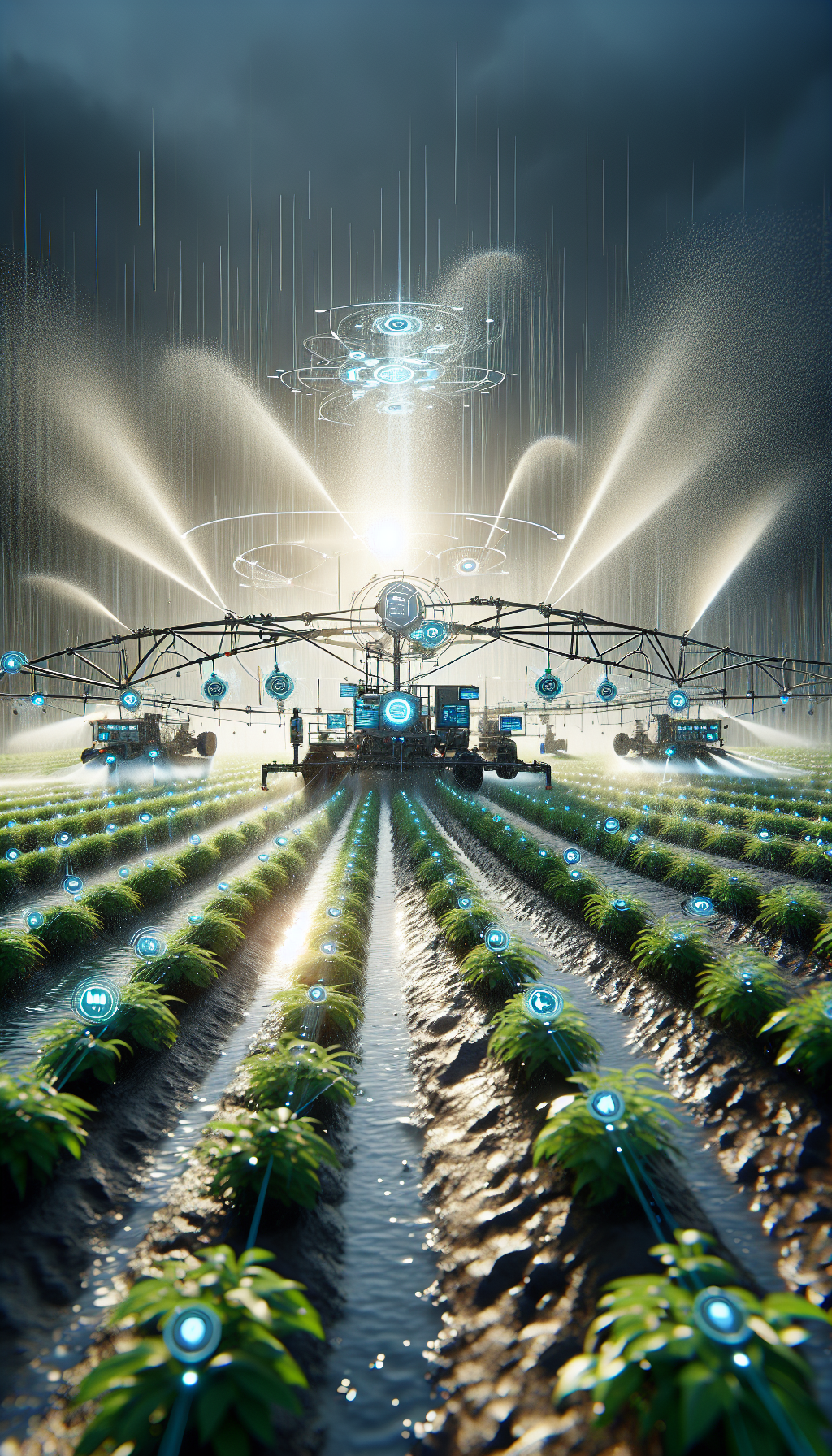The Role of AI in Sustainability
Artificial Intelligence (AI) is playing a pivotal role in driving sustainability efforts across various sectors. By leveraging AI technologies, businesses and governments are able to optimize energy consumption, reduce waste, and enhance resource management. One of the most significant contributions of AI is its ability to analyze large datasets to identify patterns and predict outcomes, which is crucial for developing efficient sustainability strategies.
Energy Management and Efficiency: AI-powered systems are increasingly being deployed to optimize energy use in buildings and industrial processes. Smart grids, for example, use AI algorithms to balance supply and demand, reducing energy waste and lowering carbon emissions. AI can also predict equipment failures and suggest preventive maintenance, ensuring that systems operate at peak efficiency.
- Smart Grids: AI facilitates real-time monitoring and management, allowing for dynamic energy distribution.
- Predictive Maintenance: Reduces downtime and extends the lifespan of equipment, contributing to sustainability.
Resource Management: Beyond energy, AI is transforming how we manage natural resources. In agriculture, AI-driven tools can analyze soil conditions and weather patterns to optimize water usage and improve crop yields. This not only conserves water but also minimizes the environmental impact of farming practices.
| Sector | AI Application | Impact |
|---|---|---|
| Energy | Smart Grids | Reduced Emissions |
| Agriculture | Precision Farming | Water Conservation |
In summary, AI is a powerful catalyst for advancing sustainability goals. By enabling more efficient energy use and resource management, AI not only supports carbon neutrality efforts but also promotes a more sustainable future. Its continued integration across various sectors holds the promise of significant environmental benefits and a reduced carbon footprint.
AI-Driven Energy Optimization
Artificial Intelligence (AI) is at the forefront of optimizing energy consumption, a critical component in the journey towards carbon neutrality. By leveraging advanced algorithms and machine learning techniques, AI systems can analyze vast amounts of data to identify patterns and inefficiencies in energy use. This data-driven approach allows for the precise management of energy resources, leading to significant reductions in waste and emissions.
One of the primary applications of AI in energy optimization is the development of smart grids. These intelligent systems utilize AI to balance supply and demand in real-time, integrating renewable energy sources such as solar and wind into the grid more efficiently. As a result, smart grids can reduce reliance on fossil fuels, lower carbon emissions, and provide more reliable energy distribution. The deployment of AI-driven smart meters further enhances this capability by providing consumers with real-time insights into their energy consumption, enabling more informed decisions about energy use.
An important aspect of AI-driven energy optimization is predictive maintenance. By using AI algorithms to monitor and predict equipment failures, energy providers can perform maintenance activities proactively, reducing downtime and improving efficiency. This not only extends the lifespan of energy infrastructure but also minimizes the environmental impact of repairs and replacements. Furthermore, AI can optimize energy storage systems, such as batteries, ensuring that excess energy generated from renewable sources is stored and utilized effectively.
Table 1 below illustrates the potential impact of AI on energy efficiency and carbon emissions reduction:
| AI Application | Energy Efficiency Improvement (%) | Carbon Emissions Reduction (%) |
|---|---|---|
| Smart Grids | 20-30 | 15-25 |
| Predictive Maintenance | 10-15 | 5-10 |
| Energy Storage Optimization | 15-20 | 10-15 |
In conclusion, AI-driven energy optimization presents a transformative opportunity to significantly advance efforts towards a carbon-neutral future. By enhancing the efficiency of energy systems and reducing waste, AI technologies not only contribute to environmental sustainability but also promote economic benefits by lowering operational costs and improving energy reliability.
Smart Grids and Renewable Integration
Smart grids represent a revolutionary approach to managing and distributing electrical power, incorporating advanced technologies to enhance the efficiency, reliability, and sustainability of energy systems. At the core of these grids is artificial intelligence (AI), which plays a crucial role in optimizing energy flow and integrating renewable sources like solar and wind into the existing infrastructure. AI algorithms analyze vast amounts of data from various sensors and smart meters, allowing for real-time adjustments in energy distribution to balance supply and demand more effectively.
A critical component of smart grids is their ability to facilitate renewable integration. Traditional grids face challenges in handling the intermittent nature of renewable energy sources. However, through AI-driven predictive analytics, smart grids can forecast energy production levels from renewable sources and adjust energy distribution accordingly. This capability ensures that renewable energy is utilized efficiently, reducing reliance on fossil fuels and minimizing carbon emissions.
Data visualizations, such as the following table, illustrate the impact of smart grids on renewable energy integration:
| Year | Renewable Energy Share (%) | Carbon Emissions Reduction (%) |
|---|---|---|
| 2020 | 20 | 5 |
| 2025 | 35 | 15 |
| 2030 | 50 | 25 |
Moreover, smart grids support distributed energy resources (DERs) by enabling decentralized energy production and consumption. This decentralization empowers consumers to become prosumers, actively participating in energy markets by producing their own electricity through rooftop solar panels or small wind turbines. AI systems can manage these diverse energy inputs and optimize their integration into the grid, enhancing overall system resilience and reducing energy waste.
AI in Carbon Footprint Monitoring
Artificial Intelligence (AI) has emerged as a powerful tool in the monitoring and reduction of carbon footprints across various sectors. By leveraging machine learning algorithms and advanced data analytics, AI systems can accurately track and analyze emissions data, offering insights that were previously unattainable. This transformative capability enables organizations to pinpoint inefficiencies and develop targeted strategies for carbon reduction. AI-driven platforms can aggregate data from multiple sources, providing a comprehensive view of emissions and facilitating more informed decision-making processes.
One of the key advantages of AI in carbon footprint monitoring is its ability to process vast amounts of data in real-time. This enables continuous monitoring and ensures that any deviations from expected emission levels are promptly identified. For instance, in manufacturing industries, AI systems can be integrated into production lines to monitor energy consumption and emissions, identifying areas where improvements can be made. Real-time data visualization through AI dashboards allows stakeholders to track progress and adjust strategies dynamically, ensuring alignment with carbon neutrality goals.
- Enhanced Data Accuracy: AI reduces the margin of error in emissions data collection, providing more reliable information for sustainability reporting.
- Predictive Analytics: By analyzing historical data, AI can forecast future emissions trends, enabling proactive measures to mitigate environmental impact.
- Automation: AI automates routine monitoring tasks, freeing up resources for strategic initiatives focused on carbon reduction.
A practical example of AI in action is in the development of smart grids. These grids utilize AI to optimize energy distribution and consumption, reducing waste and promoting the use of renewable energy sources. The incorporation of AI not only enhances efficiency but also supports the transition to a more sustainable energy infrastructure. The following table highlights some of the AI technologies used in carbon footprint monitoring:
| Technology | Application |
|---|---|
| Machine Learning Algorithms | Predicting emission patterns and identifying reduction opportunities |
| IoT Sensors | Collecting real-time data on energy usage and emissions |
| Data Analytics Platforms | Aggregating and analyzing emissions data for actionable insights |
Predictive Analytics for Resource Management
Predictive analytics is at the forefront of revolutionizing resource management in the quest for carbon neutrality. By leveraging vast amounts of data, AI systems can identify patterns and predict future energy demands with remarkable accuracy. This capability enables energy providers to optimize the allocation of resources, thereby reducing waste and enhancing efficiency. For instance, predictive analytics can forecast peak energy usage times, allowing for preemptive adjustments in energy distribution to ensure a balanced and sustainable supply.
Incorporating predictive analytics into resource management strategies involves a combination of machine learning algorithms and real-time data processing. These technologies allow for the continuous monitoring of energy consumption patterns and environmental conditions. The data collected is then analyzed to predict potential shortages or surpluses in energy supply. By integrating these predictions, companies can implement proactive measures that minimize carbon emissions and maximize resource efficiency.
Furthermore, predictive analytics supports the development of smart grids, which utilize real-time data to enhance the reliability and efficiency of energy distribution systems. Smart grids can dynamically adjust to fluctuations in energy supply and demand, ensuring optimal performance and minimal environmental impact. These advanced systems are crucial in managing renewable energy sources, such as solar and wind, which are inherently variable.
To illustrate the impact of predictive analytics on resource management, consider the following data visualization:
| Month | Predicted Energy Demand (MW) | Actual Energy Demand (MW) |
|---|---|---|
| January | 500 | 495 |
| February | 480 | 478 |
| March | 520 | 515 |
| April | 510 | 508 |
This table demonstrates how predictive analytics can closely align predicted energy demands with actual usage, underscoring the accuracy and effectiveness of these systems in resource management. By continuing to refine these technologies, we move closer to achieving a carbon-neutral future.
AI-Powered Transportation Solutions
Artificial intelligence is revolutionizing the transportation sector, playing a pivotal role in reducing carbon emissions and promoting sustainability. By optimizing traffic flow and enhancing the efficiency of public transport systems, AI technologies are reducing the carbon footprint associated with transportation. Smart traffic management systems utilize real-time data to manage congestion, reduce idle times, and minimize fuel consumption. With the integration of AI, cities can implement adaptive traffic signals that adjust based on current traffic conditions, leading to smoother traffic flow and decreased emissions.
In addition to improving traffic systems, AI is also at the forefront of advancing electric and autonomous vehicles. By leveraging AI algorithms, these vehicles can optimize routes, leading to more efficient energy usage and reduced emissions. For instance, AI can analyze various factors such as weather conditions, traffic patterns, and road gradients to suggest the most efficient routes. Furthermore, AI-driven predictive maintenance can ensure that vehicles operate optimally, preventing energy waste and reducing the need for repairs.
AI is also enhancing public transportation networks through smarter scheduling and routing. By predicting passenger demand and adjusting service frequency accordingly, AI helps in minimizing the number of vehicles on the road while maximizing their efficiency. This not only reduces emissions but also improves the overall user experience, encouraging more people to opt for public transportation. Additionally, AI assists in the management of logistics and supply chain operations, ensuring that goods are transported in the most efficient and environmentally friendly manner.
The combination of AI and transportation is further exemplified in the development of shared mobility services. Platforms powered by AI can optimize the allocation of shared vehicles, ensuring they are used to their fullest potential while minimizing idle times. This contributes to a significant reduction in the number of privately owned vehicles on the road, thereby decreasing overall emissions. By promoting car-sharing and ride-sharing services, AI is playing a crucial role in the shift towards sustainable urban mobility.
Enhancing Circular Economy with AI
The integration of artificial intelligence into the circular economy is revolutionizing how we approach sustainability and waste management. Through the use of AI, businesses can optimize resource use, minimize waste, and create more efficient recycling processes. By leveraging machine learning algorithms, companies are able to predict and manage waste streams more effectively, ensuring that materials are continually reused rather than discarded. This not only reduces the environmental impact but also enhances economic efficiency.
AI-powered predictive analytics play a crucial role in identifying patterns in waste production and consumption. This allows for the design of more efficient systems that can adapt to changing conditions. For instance, AI systems can analyze data from various sources, such as sensors and IoT devices, to track material flow and identify bottlenecks in recycling processes. This information is invaluable for developing strategies that enhance the circular economy, ensuring that resources are kept in use for as long as possible.
Moreover, AI technologies facilitate the development of smart sorting systems that improve recycling rates. These systems use computer vision and robotics to identify and sort materials with high precision. The implementation of such technology has shown to increase the purity of recycled materials, making them more economically viable for reuse. Additionally, AI can help in the creation of digital platforms that connect different stakeholders in the circular economy, fostering collaboration and innovation in sustainable practices.
| AI Applications | Benefits |
|---|---|
| Predictive Analytics | Improved waste management and resource efficiency |
| Smart Sorting Systems | Higher recycling rates and material purity |
| Digital Collaboration Platforms | Enhanced stakeholder collaboration and innovation |
The implementation of AI in the circular economy is not without its challenges. However, with the right approach and investment, these technologies have the potential to significantly advance our efforts towards a more sustainable, carbon-neutral future. By continuing to explore and expand the use of AI in this domain, we can create a more resilient and efficient circular economy that benefits both the environment and the economy.
AI in Sustainable Agriculture
Artificial intelligence is revolutionizing sustainable agriculture by enhancing resource efficiency and optimizing crop yields. By leveraging machine learning algorithms and predictive analytics, AI systems can analyze vast datasets from various sources such as weather patterns, soil conditions, and crop health. This information is crucial for farmers to make informed decisions about planting, irrigation, and harvesting, ultimately reducing waste and conserving resources. For instance, AI-driven models can predict the best times for sowing and harvesting, which can lead to an increase in productivity by up to 20%.
The integration of AI in agriculture also facilitates the development of precision farming techniques. These techniques involve the use of AI-powered drones and sensors that monitor fields in real-time, providing detailed insights into the health and needs of crops. With this data, farmers can apply fertilizers and pesticides more precisely, minimizing their environmental impact. The adoption of AI technologies in agriculture has been shown to reduce chemical usage by 30% while maintaining crop health and productivity.
Moreover, AI aids in the development of sustainable supply chains by improving logistics and reducing food waste. Smart algorithms can optimize the routes for transporting goods, ensuring that produce reaches markets faster and fresher. Additionally, AI can predict demand fluctuations, helping to align production with consumer needs and reducing the amount of food that goes to waste. This optimization not only supports environmental goals but also enhances the economic viability of farming operations.
In summary, AI is playing a pivotal role in transforming agriculture into a more sustainable industry. By harnessing the power of data, AI technologies enable farmers to utilize resources more efficiently and reduce their environmental footprint. As AI continues to evolve, its applications in agriculture will likely expand, further contributing to the global effort towards carbon neutrality.
Climate Modeling and AI
Climate modeling has long been a cornerstone in understanding and predicting climate change, but the complexity of climate systems poses significant challenges. Artificial intelligence is now playing a crucial role in enhancing these models, allowing for more accurate and granular predictions. Through machine learning algorithms, AI can analyze vast amounts of climate data, identify patterns, and make predictions that would be impossible for traditional models. This advancement not only enhances our understanding of potential future climate scenarios but also aids in crafting effective mitigation strategies.
AI-driven climate models are particularly effective in processing data from various sources such as satellite imagery, ocean buoys, and weather stations. By integrating these diverse data sets, AI models can improve the accuracy of climate predictions. For instance, AI can help in predicting extreme weather events more reliably, giving communities more time to prepare and adapt. Additionally, AI’s ability to simulate numerous climate scenarios quickly allows researchers to test the impacts of different carbon reduction strategies, providing valuable insights for policymakers.
Moreover, AI technologies are helping to democratize climate modeling. Traditionally, complex climate simulations required significant computational resources, limiting their accessibility to well-funded institutions. However, AI’s efficiency in processing and analyzing data enables wider participation in climate research.
- Open-source AI tools and platforms are emerging, allowing smaller research teams and developing countries to contribute to global climate modeling efforts.
- The collaborative nature of AI-driven climate modeling fosters innovation and accelerates the development of solutions to achieve carbon neutrality.
As AI continues to evolve, its integration with climate modeling is expected to deepen. Future advancements may include the development of hybrid models that combine AI with traditional physics-based approaches, offering even greater accuracy and reliability. By leveraging AI, the scientific community is better equipped to address the urgent challenges of climate change, ultimately paving the way to a carbon-neutral future.
AI for Waste Reduction
Artificial Intelligence (AI) is increasingly being utilized to tackle the global challenge of waste reduction. By leveraging advanced algorithms and machine learning techniques, AI can optimize waste management processes, reduce waste generation, and enhance recycling efforts. Through the use of smart sensors and data analytics, AI systems can efficiently monitor waste levels, predict waste generation patterns, and optimize collection routes, thereby minimizing environmental impact and operational costs.
One of the key innovations in this domain is the deployment of AI-powered sorting systems. These systems use computer vision and robotic arms to identify and sort recyclable materials from waste streams more accurately and faster than traditional methods. This not only increases the efficiency of recycling facilities but also ensures a higher quality of recycled products. In addition, AI can assist in identifying areas where waste can be reduced at the source by analyzing consumption patterns and suggesting more sustainable practices.
- Smart waste bins equipped with AI sensors can alert waste management services when they are full, optimizing collection schedules and reducing unnecessary trips.
- Predictive analytics can forecast peak waste generation times, allowing for better resource allocation and manpower deployment.
- AI-driven platforms can facilitate circular economy models by connecting producers of waste with recyclers and manufacturers, creating a sustainable loop of resource utilization.
| AI Application | Benefit |
|---|---|
| AI Sorting Systems | Enhanced accuracy and speed in recycling processes |
| Smart Waste Bins | Optimized waste collection and reduced operational costs |
| Predictive Analytics | Efficient resource allocation and waste management |
The integration of AI into waste management not only contributes to significant cost savings but also plays a crucial role in environmental sustainability. By minimizing waste and maximizing the reuse of materials, AI helps in reducing the carbon footprint associated with waste disposal and promotes a greener future.
Challenges in AI Adoption for Sustainability
The path to integrating AI into sustainability efforts is fraught with challenges that can hinder its potential impact. One of the primary obstacles is the lack of standardized data. AI systems rely heavily on large datasets to function optimally, yet the data related to environmental metrics and carbon emissions are often inconsistent and fragmented. This inconsistency makes it difficult for AI algorithms to draw accurate conclusions or make reliable predictions. As a result, efforts to streamline data collection and establish uniform standards are critical.
Another significant challenge is the high cost of implementation. Developing and deploying AI technologies require substantial financial investments, which can be a barrier for many organizations, especially small and medium enterprises. Moreover, the ongoing maintenance and updating of AI systems add to the overall expense. To overcome these financial hurdles, there needs to be a collaborative effort involving government incentives, private sector partnerships, and international funding mechanisms.
Despite the promise of AI, there is also an ethical dimension to its adoption in sustainability. Concerns about privacy, data security, and the potential for AI to replace human jobs are prevalent. To address these issues, it is essential to establish robust regulatory frameworks that ensure ethical AI use while promoting transparency and accountability. Engaging stakeholders across sectors in dialogue about these ethical considerations can help in building trust and facilitating smoother AI integration.
Finally, the skills gap in the workforce presents a significant challenge. AI technologies require specialized knowledge and expertise, which are not yet widespread in the sustainability sector. To bridge this gap, educational institutions and industry leaders must collaborate to develop targeted training programs and curricula. By equipping the workforce with the necessary skills, organizations can more effectively leverage AI to achieve carbon neutrality.
Future Trends in AI and Carbon Neutrality
As we look to the future, the integration of artificial intelligence in the pursuit of carbon neutrality is poised to accelerate. AI-driven technologies are expected to become more sophisticated, enabling more precise predictions and optimizations in energy consumption. One significant trend is the development of autonomous energy systems that leverage AI to manage and distribute energy more efficiently. These systems can dynamically adjust energy loads in real-time, reducing waste and enhancing the use of renewable resources.
Another emerging trend is the use of AI for predictive maintenance in renewable energy infrastructure. By analyzing data from sensors and historical performance, AI can predict equipment failures before they occur, minimizing downtime and maintenance costs. This proactive approach not only extends the lifespan of renewable energy assets but also ensures a more reliable energy supply. The table below highlights some key areas where AI is making an impact:
| Area | AI Application | Impact |
|---|---|---|
| Energy Management | Smart Grids | Optimized energy distribution |
| Resource Allocation | Predictive Algorithms | Improved efficiency |
| Infrastructure Maintenance | Predictive Maintenance | Reduced costs and downtime |
Moreover, advancements in AI are expected to enhance carbon capture and storage technologies. AI can optimize the processes involved in capturing carbon emissions from industrial sources and improve storage solutions. By using machine learning models, these technologies can be continuously improved, making them more effective and economically viable. As AI continues to evolve, its role in the transition to a carbon-neutral world will undoubtedly grow, offering innovative solutions and unprecedented opportunities for sustainability.



